During the 150th anniversary of Rachmaninoff’s birth, pianist Yuja Wang undertook an extraordinary feat. She performed all the Rachmaninoff Piano Concertos and the Rhapsody on a Theme of Paganini in one marathon concert at Carnegie Hall on January 28, 2023. Wang appeared with the Philadelphia Orchestra and Maestro Yannick Nézet- Séguin. The audience was treated to a four-hour program, with two intermissions, consisting of 97,076 notes and 621 pages of music. But who’s counting? It turns out that noting the numbers was part of the evening. Wang was asked to wear a device to track her heartbeat during the concert, and so did the conductor, nine members of the orchestra, and six members of the audience. The results of this experiment are quite extraordinary.
The ganjingworld investigation began with statistics: Yuja Wang has played so far, Rachmaninoff Piano Concerto No. 2, thirty-five times, Rachmaninoff Piano Concerto No. 1, fourteen times, Rachmaninoff Piano Concerto No. 4, twenty-one times, Rachmaninoff Rhapsody on a Theme of Paganini thirty-one times, and Rachmaninoff Piano Concerto No. 3, a total of 72 times.
No one had ever attempted playing all of Rachmaninoff’s five works for piano solo with the orchestra before. Who else would have the stamina to do it? It’s akin to winning a gold medal in the Olympics or climbing Mount Everest.

In planning the program, Yuja decided the 3rd Piano Concerto had to conclude the program as it is the epitome of emotion, drama, and physicality. Who can play anything after that?
Sergei Rachmaninoff: Piano Concerto No. 3 in D Minor, Op. 30 – III. Finale: Alla breve (Yuja Wang, piano; Los Angeles Philharmonic Orchestra; Gustavo Dudamel, cond.)
Unsurprisingly, Wang’s virtuosity and musicality were riveting from beginning to end. Wang also amazed the audience with a different outfit for each concerto while keeping track of the tracking device.
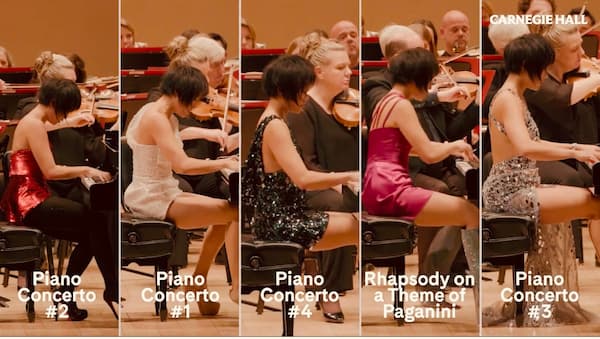
© Carnegie Hall
When the results were revealed to Wang, it was uncanny that she could look at the graph and identify exactly where she was in the music just by looking at the peaks and the valleys of her heartbeats.
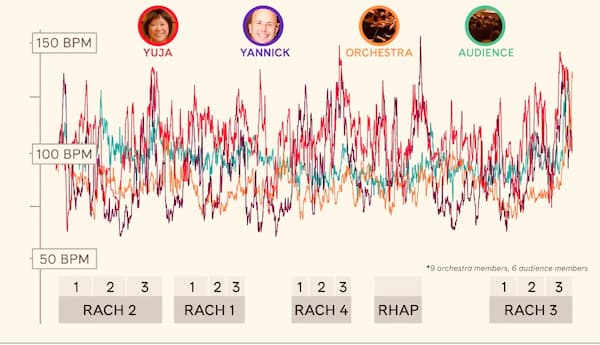
The highest peaks, of course, occur where the music is physically or psychologically difficult. As a benchmark note, resting beats per minute is approximately 62 BPM. During the finale of the 2nd Concerto, her heart rate reached 139 BPM, predictably where there are more notes, and it’s faster and louder. During the finale of the 3rd Concerto, she surpassed that number at 146 BPM. But the highest level reached 149 BPM— 233% more than resting—was during the finale of the 4th Concerto.
Sergei Rachmaninoff: Piano Concerto No. 4 in G Minor, Op. 40 (1941 version) – III. Allegro vivace (Yuja Wang, piano; Los Angeles Philharmonic Orchestra; Gustavo Dudamel, cond.)
The interesting thing is that Wang’s heart rate didn’t always consistently go up when it was loud and fast or just in the finales. In fact, the 3rd Concerto, despite being the longest and most difficult concerto, on average, indicated the lowest BPM rates. Wang thinks there are two reasons for this slower heart rate. Spiritually, the piece has a calming effect on her. Technically, as an elite and superbly skilled pianist, she’s able to save her energy when needed during the performance. Her heart rate is affected by how economical her movements are.
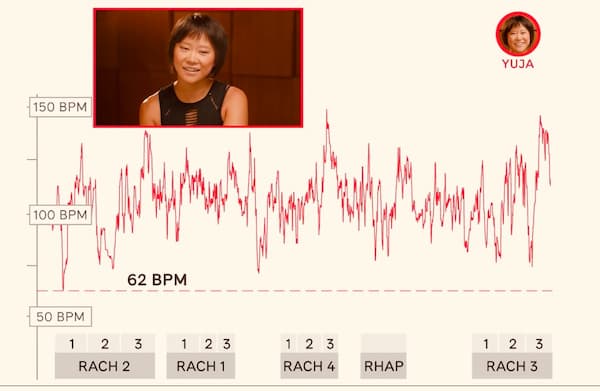
There is a third possibility to consider. Perhaps the reason her heartbeats were higher in the first and fourth concertos is that Wang has had the least experience performing these works. If she was more keyed up, it certainly would affect one’s heart rate.
Another statistic amused Yuja Wang. The numbers indicated how much harder she worked than the conductor. She: 2,427 calories burned and 20,275 steps taken; He: 1,645 calories burned and 15,079 steps taken.
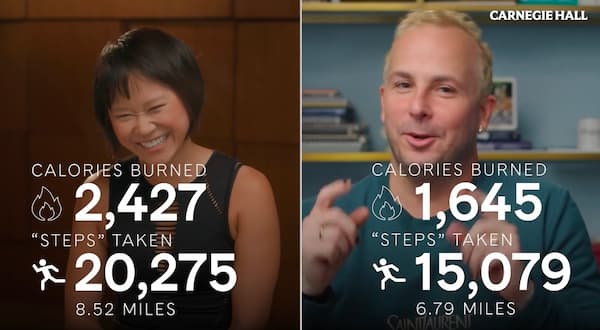
Vindicated! We musicians know this! But Yannick actually recorded the highest peak, higher than any of Wang’s uppermost BPMs, when he reached 153 BPM in the final variations #19-24 of the Rhapsody on a Theme of Paganini. It is, of course, a very exciting ending, and it’s strenuous to marshal all the musicians for this mighty climax, as it is for us to play it.
Sergei Rachmaninoff: Rhapsody on a Theme of Paganini, Op. 43 (Yuja Wang, piano; Mahler Chamber Orchestra; Claudio Abbado, cond.)
Throughout his career, Nézet-Seguin has sought to bring people in sync with his music-making. He was astonished when he saw this reflected on the graph. There is an amazing synchronicity when comparing the heartbeats of the soloist and the conductor. Yuja and Yannick were musically and physically on the same wavelength throughout. But even more impressive, even during Wang’s cadenzas, when the orchestra and the conductor were “at rest,” their heartbeats rose in sync with the soloist’s playing and emotion. Whenever the music became more emotionally intense, the constant interdependence between all the musicians on stage, even when they weren’t playing, was notable. The phenomenon could be seen in the tracking devices of audience members as well. Their heartbeats went up, too, during the emotionally moving sections.
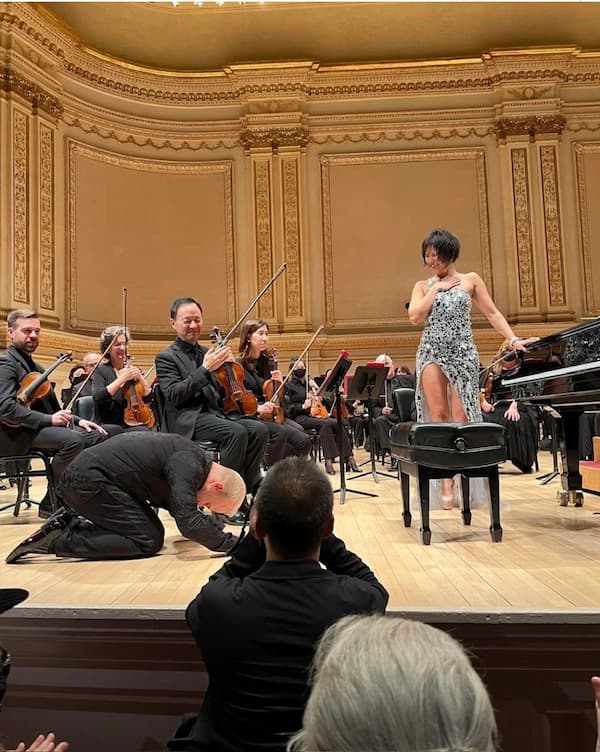
Does this occur in other settings? Choir music and song have permeated civilisations throughout different cultures and religions. In a 2013 study, it was documented that when choirs sing, their heartbeats become synchronized, beating as one. An article in NPR and the BBC World Service in July of 2013 reported that researchers of the Sahlgrenska Academy at the University of Gothenburg in Sweden studied the heart rates of a high school choir in a variety of choral works. They published their results in Frontiers in Neuroscience. Singers must exhale and inhale in a coordinated fashion. The findings showed that singing in a choir calmed the singer’s heart rate, especially when they were singing in unison, and within a few moments, each person’s heartbeat became synchronised. Somehow, the singers’ collective consciousness is connected to each other. Their controlled breathing, as we’ve seen in yoga and in other meditational practices, had a quietening effect.
Listen to The VocalEssence Ensemble Singers conducted by Philip Brunelle perform “The Day is Done” by Minnesota composer Stephen Paulus to a poem by Henry Wadsworth Longfellow. “And the night shall be filled with music, And the cares, that infest the day, Shall be banished like restless feelings, That silently steal away.”
I can’t help respiring, sighing with them.
Stephen Paulus: The Day in Done
Choirs breathe together, but so do wind and brass musicians in a band, ensemble, or orchestra—to make a phrase, to play seamlessly, and to express the musical lines homogeneously. Many audience members may not know that string players must also breathe together, especially during chamber music performances when we don’t have a conductor. The sniff at the beginning of a piece, in addition to body language, will lead colleagues, much like a conductor’s upbeat, and the rate of the sniff indicates many things—when to play, the type of entrance, the rhythm, the meter, the style. Breathing helps us stay together and to feel the music as one.
The Yuja Wang Rachmaninoff Heartbeat Study was more than an amusing experiment. Dr. Bjorn Vickhoff concludes, “We speculate that it is possible singing could also be beneficial.” Performing and listening to music is good for us and is a positive experience which can synchronise our heartbeats. Unlike many other activities, music can bring people of all ages, cultures, and backgrounds together, in sync, in harmony, despite wide-ranging experiences with music.
Here is the video of the entire study courtesy of Yuja Wang, and Carnegie Hall, director Joe Sabia, producer Greg T. Gordon, Images Carnegie Hall Rose Archives, Cartoon Jeffrey Curnow.
For more of the best in classical music, sign up for our E-Newsletter

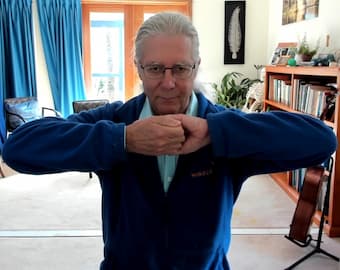


Absolutely fascinating! These weekly newsletters are a musical highlight and treat.
L’article le plus enthousiasment que j’ai lu dans ma vie.
Fascinating and remarkably well explained. Thank-you for doing this. I will definitely share it with others and look forward to reading many of your other articles.
Truly fascinating. The word that occurs to all of us.
Even for an analysis junky, this was exceptional. Excellently explained.